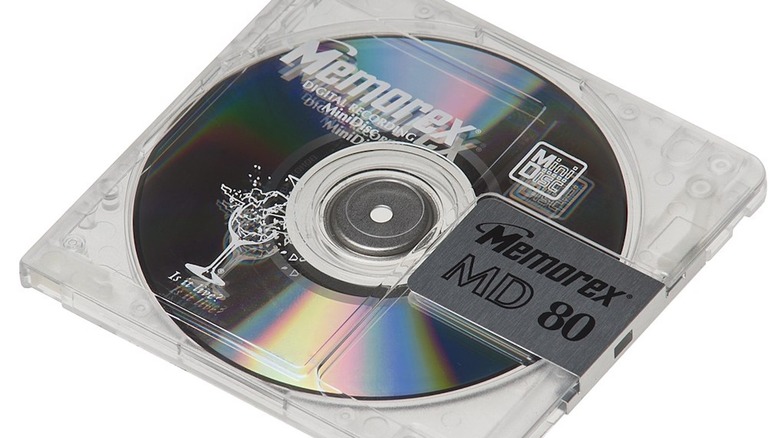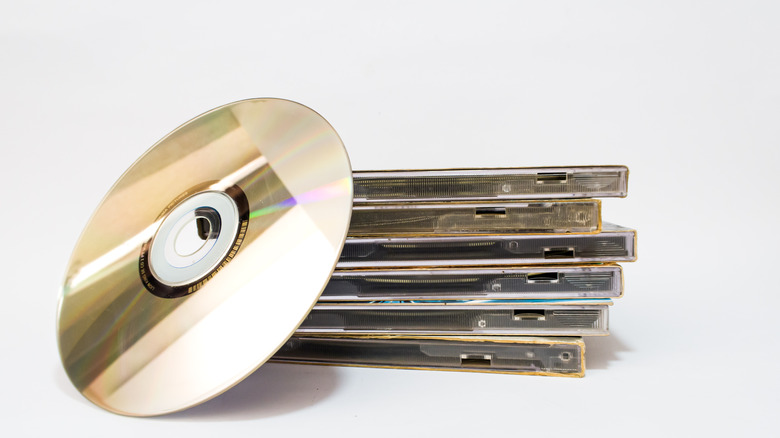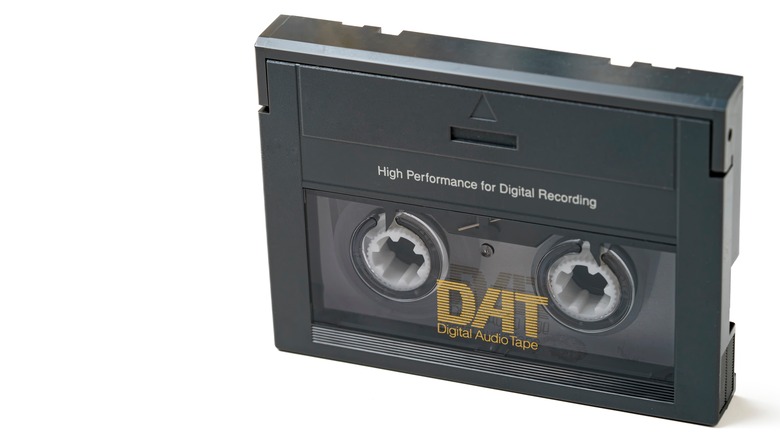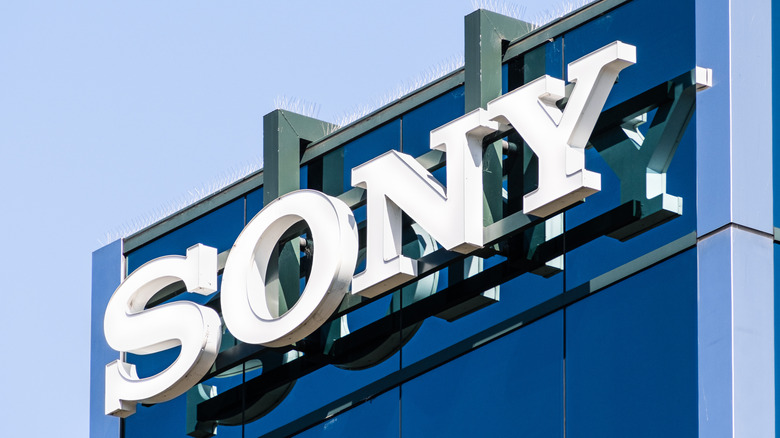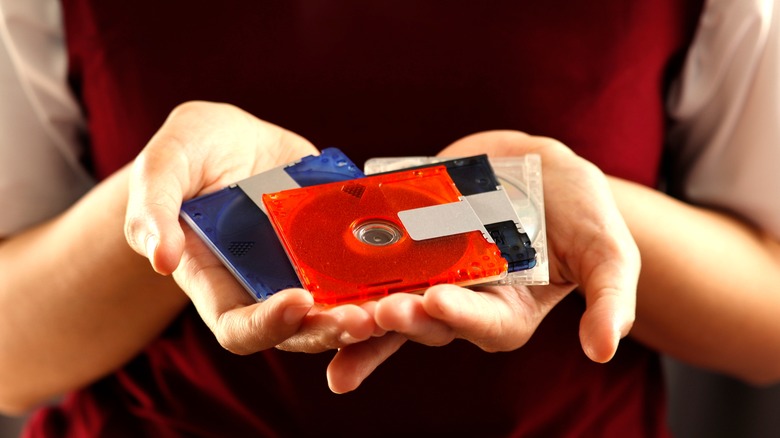What Happened To MiniDiscs?
Mediums for recorded audio have changed a lot over the years, and each new generation tries to make up for the shortcomings of the technology that came before it. Thomas Edison invented the phonograph in 1877, and though it originally used tin foil cylinders, it eventually switched to more durable and better-sounding wax cylinders (via Tees Valley Museums). According to COMSOL, next were 78 rpm vinyl records and then 33⅓ rpm and 45 rpm records came along with their respective advantages over the previous 78s.
Vinyl ruled until the 1960s, when audio cassettes set off a decades-long deluge of new forms of recorded audio media, including 8-tracks, microcassettes, CDs, and digital audio tape, among others. MP3s came along and erased the need for physical media (per Yale University Library). In between all of those innovations were other creations that simply failed to catch on for one reason or another. One of those was Sony's MiniDisc.
The CD was king through the '80s
There couldn't be a MiniDisc without the compact disc. Compact discs — or DCs, as everyone on the planet calls them — were invented in 1979. That was the year that a prototype of CD technology was put on display in Europe and Japan, and major electronics companies Philips and Sony put aside competition and worked together to develop a consumer version of CD technology (per the BBC).
In 1982, Swedish pop group ABBA released their album "The Visitors" on CD, making it the first commercially available album using the storage format. Just the year before, the BBC television program "Tomorrow's World" ran a segment on burgeoning technology, and the presenter pondered "whether there's a market for this kind of disc."
To put it mildly, there was. CDs had some major advantages over cassettes, including the ability to skip from track to track, plus there was no need to rewind or flip a CD halfway through an album. According to Time, when they were rolled out, CD players cost thousands, and CDs themselves cost about $17 — around $40 today — a piece. But sell they did, and the number of CDs sold increased each year until the early 2000s (via Statista).
Attempts to dethrone CDs
The nature of the technological arms race to come up with the next big thing in recorded audio format — which by the 1990s had been going on for over a century — is that it has to keep moving forward, and several new forms of technology entered the fray.
According to Yale University Library, digital audio tape, or DAT, was introduced in 1987. It combined the digital technology employed in CDs and crossed it with magnetic tape, which had been around for decades. DAT cassettes came out in 1990, but they never really caught on with the general public (via Techopedia), partially because of the simple fact that not many recordings were released using the format. However, the digital audio tape was used in a lot of recording studios into the 2000s.
Just a few years after DAT cassettes were introduced, Sony — who had helped engineer the first consumer CDs — thought they had come up with the answer to what would replace CDs once and for all.
Sony releases MiniDiscs
According to Open Culture, Sony founder Akio Morita once said, "If you ask the public what they think they'll need, you'll always be behind in this world. You'll never catch up unless you think one to 10 years in advance and create a market for the items you think the public will accept at that time." It could be reasoned that this philosophy is why Sony put its eggs in the MiniDisc basket while the rest of the industry focused on digital audio tape cassettes.
MiniDiscs, as the name implies, look just like small CDs, but the big difference is that the disc itself is encased in plastic. According to Slate, this combines the digital recording technology CDs with the functionality of traditional cassettes. Portability was one of MiniDisc's main draws as they were just half the size of those old, cumbersome CDs yet still retained the audio quality and the amount of recording time.
Surely, MiniDiscs were destined to be the next big thing in audio technology.
The decline of MiniDiscs
Alright, so maybe not. MiniDiscs — much like DAT cassettes, microcassettes, 8-track, and Betamax tapes — failed to find an audience, at least in the United States. According to Slate, one of, if not the biggest problem, was that music labels weren't releasing recordings on MiniDiscs. The reason was that while MiniDiscs used similar technology to CDs, the equipment needed to record on them was completely different. This meant music labels weren't releasing recordings on MiniDisc because of the specialized equipment needed to produce them. At the same time, consumers also needed their own equipment to play MiniDiscs, and since labels weren't putting out much on MiniDisc, there wasn't much demand for them.
However, in Sony's home turf of Japan, MiniDiscs became very popular (via Open Culture). There, CDs were twice the price of MiniDiscs, which led to people renting CDs and transferring their data to the cheaper technology. Although this drove some court battles between music stores and record labels, it also propelled MiniDiscs sales figures past CDs in Japan.
MiniDiscs today
Coming just behind MiniDiscs were MP3s, and that was pretty much the end of new physical music formats. According to Slate, MiniDiscs did find use in professional settings. Radio stations used them somewhat frequently, as did some recording artists (most notably British band Radiohead). According to The Guardian, in 2019, hours' worth of unreleased songs were stolen from the band's frontman Thom Yorke. This was done by hacking his computer, but many of the songs had been originally recorded on MiniDisc in the 1990s during the sessions for Radiohead's album "OK Computer."
It remains to be seen if MiniDiscs are gone for good. In all likelihood, they are, but consumers have surprised the recording industry before. The arrival of CDs was supposed to be the end for vinyl records, but 2020 marked the first time in decades that vinyl record sales topped CD sales (via The Manual). However, CDs then saw a surge in 2021 after 17 years of declining sales (via Market Watch). So maybe someday the MiniDisc will become the next big thing once again.
